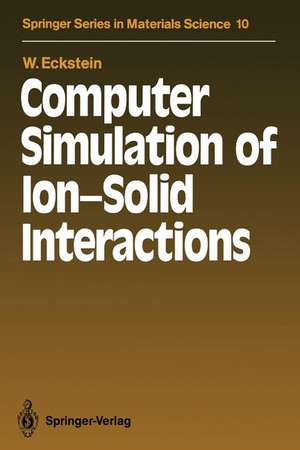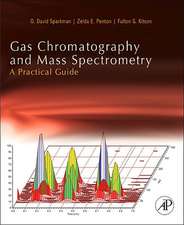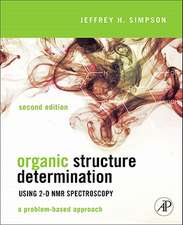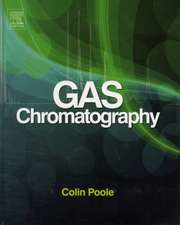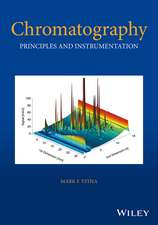Computer Simulation of Ion-Solid Interactions: Springer Series in Materials Science, cartea 10
Autor Wolfgang Ecksteinen Limba Engleză Paperback – 22 noi 2011
Din seria Springer Series in Materials Science
- 18%
 Preț: 1820.22 lei
Preț: 1820.22 lei - 18%
 Preț: 776.09 lei
Preț: 776.09 lei - 24%
 Preț: 689.68 lei
Preț: 689.68 lei - 18%
 Preț: 968.96 lei
Preț: 968.96 lei - 20%
 Preț: 568.94 lei
Preț: 568.94 lei - 18%
 Preț: 953.65 lei
Preț: 953.65 lei - 18%
 Preț: 902.36 lei
Preț: 902.36 lei - 18%
 Preț: 953.65 lei
Preț: 953.65 lei - 20%
 Preț: 948.41 lei
Preț: 948.41 lei - 18%
 Preț: 1143.07 lei
Preț: 1143.07 lei - 18%
 Preț: 1111.53 lei
Preț: 1111.53 lei - 18%
 Preț: 1103.62 lei
Preț: 1103.62 lei - 18%
 Preț: 1225.94 lei
Preț: 1225.94 lei -
 Preț: 473.91 lei
Preț: 473.91 lei - 18%
 Preț: 782.42 lei
Preț: 782.42 lei -
 Preț: 433.47 lei
Preț: 433.47 lei - 18%
 Preț: 1116.40 lei
Preț: 1116.40 lei - 18%
 Preț: 723.03 lei
Preț: 723.03 lei - 18%
 Preț: 958.56 lei
Preț: 958.56 lei - 18%
 Preț: 1224.36 lei
Preț: 1224.36 lei - 15%
 Preț: 644.82 lei
Preț: 644.82 lei - 24%
 Preț: 833.43 lei
Preț: 833.43 lei - 24%
 Preț: 1060.33 lei
Preț: 1060.33 lei - 18%
 Preț: 964.10 lei
Preț: 964.10 lei - 18%
 Preț: 1224.36 lei
Preț: 1224.36 lei - 18%
 Preț: 1221.20 lei
Preț: 1221.20 lei - 18%
 Preț: 946.87 lei
Preț: 946.87 lei - 18%
 Preț: 1842.31 lei
Preț: 1842.31 lei - 15%
 Preț: 643.34 lei
Preț: 643.34 lei - 18%
 Preț: 1246.32 lei
Preț: 1246.32 lei - 18%
 Preț: 956.81 lei
Preț: 956.81 lei - 18%
 Preț: 953.52 lei
Preț: 953.52 lei - 15%
 Preț: 637.59 lei
Preț: 637.59 lei - 18%
 Preț: 1235.43 lei
Preț: 1235.43 lei
Preț: 641.20 lei
Preț vechi: 754.36 lei
-15% Nou
Puncte Express: 962
Preț estimativ în valută:
122.72€ • 126.47$ • 103.61£
122.72€ • 126.47$ • 103.61£
Carte tipărită la comandă
Livrare economică 03-17 martie
Preluare comenzi: 021 569.72.76
Specificații
ISBN-13: 9783642735158
ISBN-10: 3642735150
Pagini: 312
Ilustrații: XI, 296 p.
Dimensiuni: 155 x 235 x 16 mm
Greutate: 0.44 kg
Ediția:Softcover reprint of the original 1st ed. 1991
Editura: Springer Berlin, Heidelberg
Colecția Springer
Seria Springer Series in Materials Science
Locul publicării:Berlin, Heidelberg, Germany
ISBN-10: 3642735150
Pagini: 312
Ilustrații: XI, 296 p.
Dimensiuni: 155 x 235 x 16 mm
Greutate: 0.44 kg
Ediția:Softcover reprint of the original 1st ed. 1991
Editura: Springer Berlin, Heidelberg
Colecția Springer
Seria Springer Series in Materials Science
Locul publicării:Berlin, Heidelberg, Germany
Public țintă
ResearchCuprins
1. Introduction.- 2. The Binary Collision Model.- 2.1 Laboratory System.- 2.2 Centre-of-Mass System.- 2.3 Relations Between Laboratory and Centre-of-Mass Systems.- 2.4 Energy Transfer.- 2.5 Classical Scattering Theory.- 2.6 Asymptotic Trajectories.- 2.7 Determination of the Scattering Angle and the Time Integral.- 2.8 Limitations of the Binary Collision Approximation.- 2.9 Limitations of the Classical Mechanics Treatment.- 3. Classical Dynamics Model.- 3.1 Newton’s Equations.- 3.2 Integration of Newton’s Equations.- 3.3 The Time Step, Bookkeeping.- 4. Interaction Potentials.- 4.1 Screened Coulomb Potentials.- 4.2 The Born-Mayer Potential.- 4.3 Attractive Potentials.- 4.4 Combined Potentials.- 4.5 Empirical Potentials.- 4.6 Embedded Atom Method.- 4.7 Analytical Methods.- 4.8 Comparison of Potentials.- 5. Inelastic Energy Loss.- 5.1 Local Electronic Energy Loss.- 5.2 Continuous Electronic Energy Loss.- 5.3 Comparison.- 6. Thermal Vibrations and Specific Energies.- 6.1 Thermal Vibrations.- 6.2 Specific Energies.- 6.2.1 Cutoff Energy.- 7. Programs Based on the BCA Model.- 7.1 Random Target Structures.- 7.2 Monte Carlo Programs.- 7.3 Crystalline Targets.- 7.4 Lattice Programs.- 7.5 TRIM.SP and TRIDYN.- 7.6 MARLOWE.- 8. Programs Based on the Classical Dynamics Model.- 8.1 Stable, Metastable and Quasi-Stable Programs.- 8.2 Classical Dynamics Programs.- 9. Trajectories.- 10. Ranges.- 10.1 Definitions.- 10.2 Literature.- 10.3 Examples.- 11. Backscattering.- 11.1 Definitions.- 11.2 Literature.- 11.3 Examples.- 12. Sputtering.- 12.1 Definitions.- 12.2 Negative Binomial Distribution.- 12.3 Literature.- 12.4 Examples.- 13. Radiation Damage.- 13.1 Definitions.- 13.2 Component Analysis.- 13.3 Fuzzy Clustering.- 13.4 Literature.- 13.5 Examples.- Abbreviations Used in the Tables.-Constants.- References.- Author Index.
